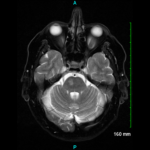Vasculitis/Polyarteritis Nodosa
5. Polyarteritis nodosa (PAN) involves the arteries but spares the veins, Dr. Stone said. He also shared that it does not affect the glomeruli.
6. Classic PAN usually occurs just once. “If you get it into remission before it kills the patient or causes devastating injury, it doesn’t come back,” Dr. Stone said. However, that is not true for anti-neutrophilic cytoplasmic autoantibody-associated vasculitis. If PAN does return, particularly in younger patients, consider screening for adenosine deaminase 2 gene deficiency, he advised. This is usually characterized by abnormal inflammation of various tissues.
 Giant Cell Arteritis
Giant Cell Arteritis
7. Don’t assume that a temporal artery biopsy is the gold standard in the diagnosis of giant cell arteritis (GCA). A patient’s history is the rheumatologist’s scalpel, Dr. Stone said. Plus, advances in positron emission tomography imaging over the past few decades can better assist with GCA diagnosis than a biopsy. He pointed out that temporal artery biopsies have several potential downsides. For instance, they may skip lesions, the temporal arteries may not be involved, there could be inadequate biopsy length, the correct part of the artery may not be biopsied, or the pathological interpretation may be wrong. A combination of clinical information, pathology, serological data and radiology results help to form a diagnosis for GCA, Dr. Stone stated.
8. A polymyalgia rheumatica patient with persistent and unexplained hoarseness may have GCA. Dr. Stone said he has diagnosed several patients who only had a cough, sore throat and hoarseness as their potential signs of GCA. Published literature as far back as the 1980s supports this possible, but perhaps unexpected link between respiratory symptoms and GCA.1
9. Don’t assume that prednisone alone is the best treatment approach for GCA patients. Some rheumatologists may assume they should stick with prednisone for GCA treatment and only use tocilizumab in GCA patients who fail prednisone, Dr. Stone stated. However, a clinical trial he led found that tocilizumab used once a week or biweekly, combined with a 26-week prednisone taper, worked more effectively for sustained glucocorticoid-free remission than a 26-week or 52-week prednisone tapering plus placebo.2 Patients with GCA also appear to have a prednisone “threshold” that tocilizumab appears to lower, Dr. Stone said. It could even permit many patients to remain off prednisone.
10. The largest risk factor for disease flare in GCA is being female. Women are three times more likely to get GCA, five times more likely to fail treatment with prednisone and 2.4 times more likely to fail treatment with prednisone plus tocilizumab, Dr. Stone said. The latter occurs even when women receive more tocilizumab per kilogram than men.2

